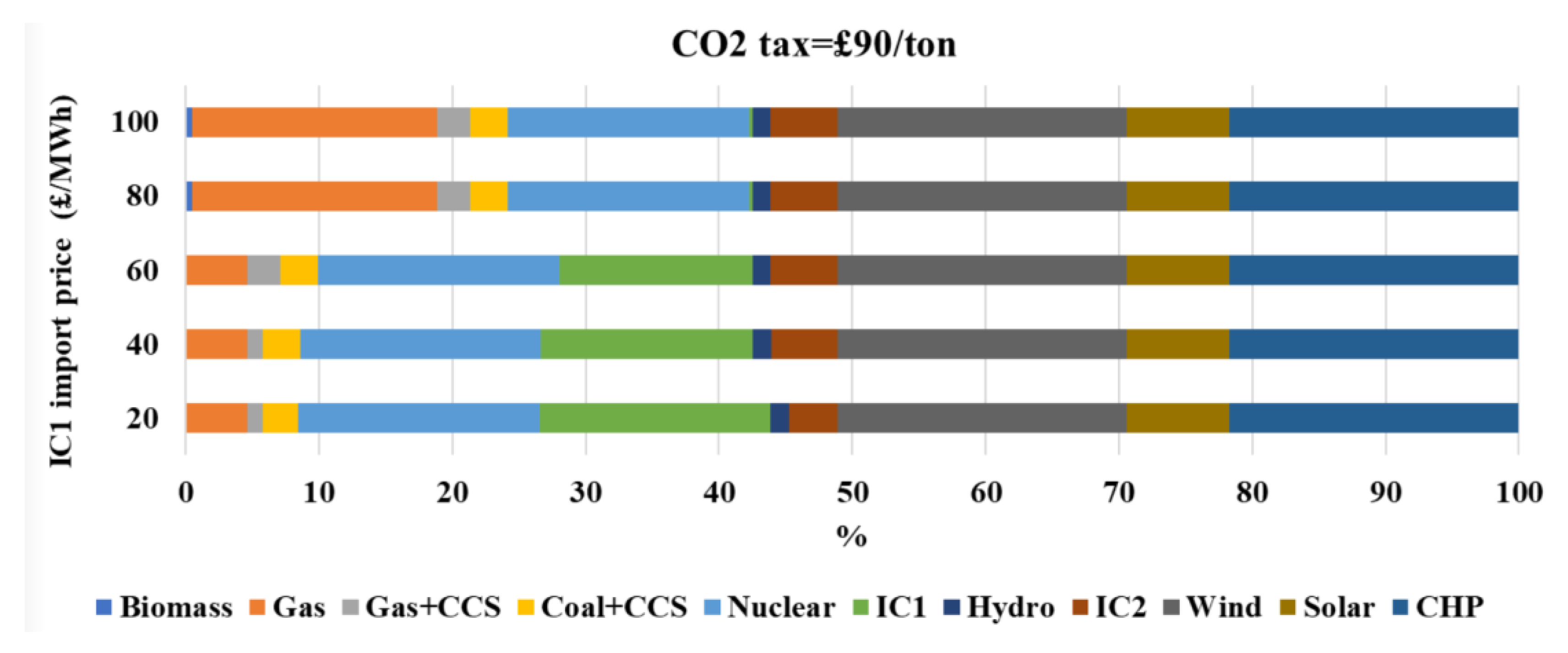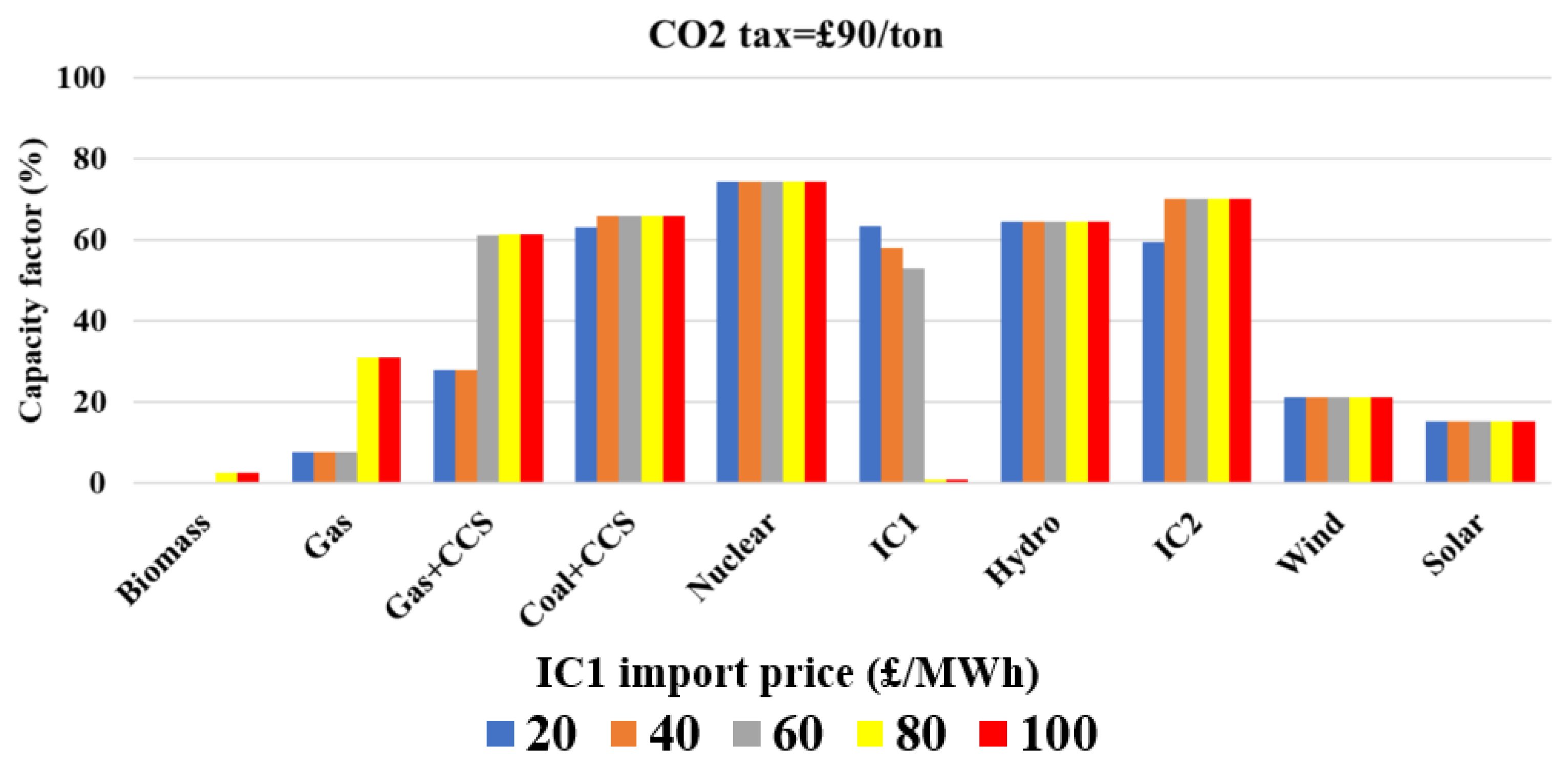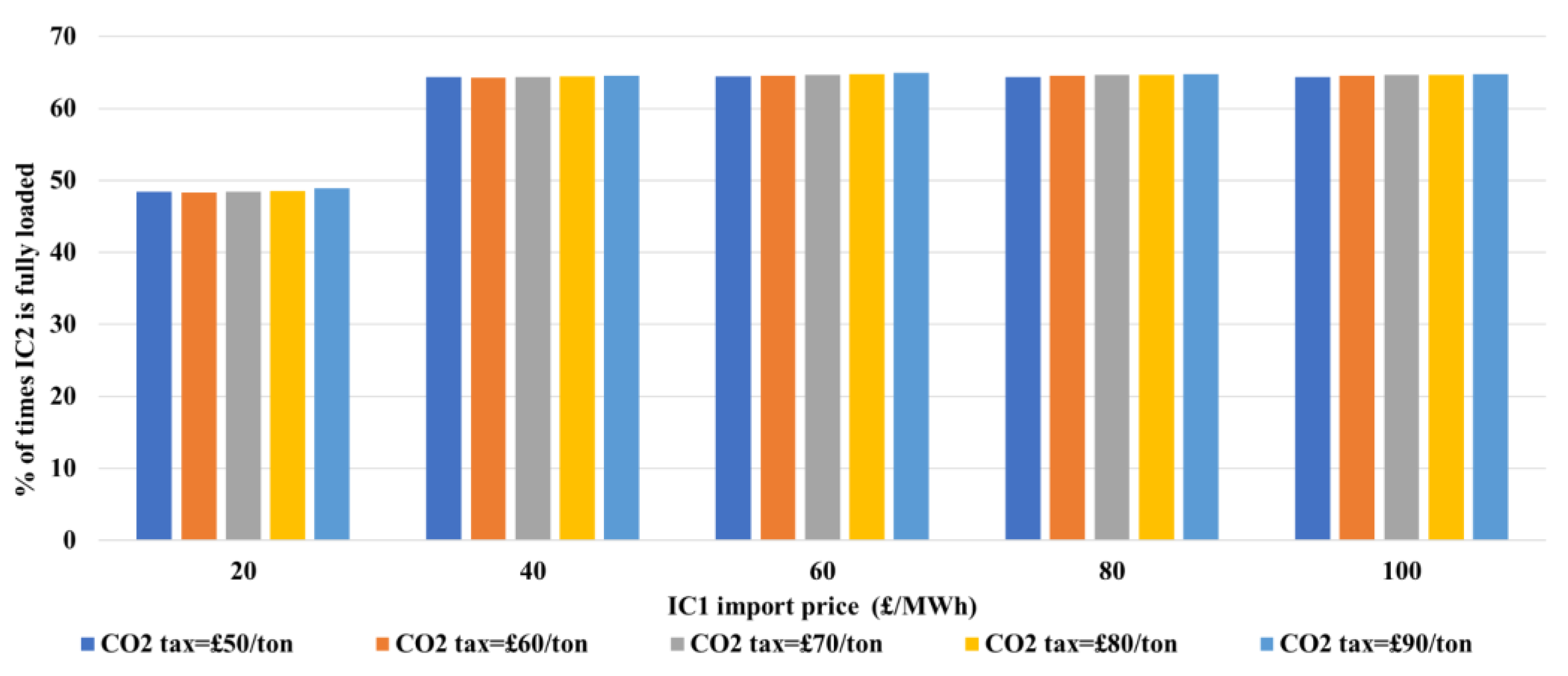The Future Impact of Carbon Tax on Electricity Flow between Great Britain and Its Neighbors until 2030
Abstract
:1. Introduction
2. Formulation of the 2030 Optimization Model
2.1. Objective Function
2.2. Constraints
3. Results and Discussion
4. Conclusions
Author Contributions
Funding
Institutional Review Board Statement
Informed Consent Statement
Conflicts of Interest
References
- Brinkerink, M.; Gallachóir, B.Ó.; Deane, P. A comprehensive review on the benefits and challenges of global power grids and intercontinental interconnectors. Renew. Sustain. Energy Rev. 2019, 107, 274–287. [Google Scholar] [CrossRef]
- Yun, W.-C.; Zhang, Z.X. Electric power grid interconnection in Northeast Asia. Energy Policy 2006, 34, 2298–2309. [Google Scholar] [CrossRef] [Green Version]
- Kanagawa, M.; Nakata, T. Analysis of the impact of electricity grid interconnection between Korea and Japan—Feasibility study for energy network in Northeast Asia. Energy Policy 2006, 34, 1015–1025. [Google Scholar] [CrossRef]
- Doorman, G.L.; Frøystad, D.M. The economic impacts of a submarine HVDC interconnection between Norway and Great Britain. Energy Policy 2013, 60, 334–344. [Google Scholar] [CrossRef]
- Konstantelos, I.; Pudjianto, D.; Strbac, G.; De Decker, J.; Joseph, P.; Flament, A.; Kreutzkamp, P.; Genoese, F.; Rehfeldt, L.; Wallasch, A.-K.; et al. Integrated North Sea grids: The costs, the benefits and their distribution between countries. Energy Policy 2016, 101, 28–41. [Google Scholar] [CrossRef]
- Voumvoulakis, E.; Asimakopoulou, G.; Danchev, S.; Maniatis, G.; Tsakanikas, A. Large scale integration of intermittent renewable energy sources in the Greek power sector. Energy Policy 2012, 50, 161–173. [Google Scholar] [CrossRef]
- Nepal, R.; Jamasb, T. Interconnections and market integration in the Irish Single Electricity Market. Energy Policy 2012, 51, 425–434. [Google Scholar] [CrossRef]
- Lynch, M.Á.; Tol, R.S.J.; O’Malley, M.J. Optimal interconnection and renewable targets for north-west Europe. Energy Policy 2012, 51, 605–617. [Google Scholar] [CrossRef] [Green Version]
- Zhu, F.; Zheng, Y.; Guo, X.; Wang, S. Environmental impacts and benefits of regional power grid interconnections for China. Energy Policy 2005, 33, 1797–1805. [Google Scholar] [CrossRef]
- Adeoye, O.; Spataru, C. Quantifying the integration of renewable energy sources in West Africa’s interconnected electricity network. Renew. Sustain. Energy Rev. 2020, 120, 109647. [Google Scholar] [CrossRef]
- Chen, Y.-K.; Koduvere, H.; Gunkel, P.A.; Kirkerud, J.G.; Skytte, K.; Ravn, H.; Bolkesjø, T.F. The role of cross-border power transmission in a renewable-rich power system—A model analysis for Northwestern Europe. J. Environ. Manag. 2020, 261, 110194. [Google Scholar] [CrossRef]
- Clegg, S.; Mancarella, P. Integrated electricity-heat-gas modelling and assessment, with applications to the Great Britain system. Part II: Transmission network analysis and low carbon technology and resilience case studies. Energy 2019, 184, 191–203. [Google Scholar] [CrossRef] [Green Version]
- Li, J.; Gao, G.; Ma, L.; Zhao, T.; Qu, H.; Chen, F. Analysis of profit models for cross-border power interconnection projects. Glob. Energy Interconnect. 2019, 2, 457–464. [Google Scholar] [CrossRef]
- Chen, C.; Liang, C.; Zhou, Y.; Wang, C.; Lu, J.; Xu, F. A multi-level evaluation model for the recognition and assessment of impact factors associated with intercontinental power interconnection projects. Glob. Energy Interconnect. 2020, 3, 30–42. [Google Scholar] [CrossRef]
- Liang, C.; Meng, J.; Chen, C.; Zhou, Y. A production-cost-simulation-based method for optimal planning of the grid interconnection between countries with rich hydro energy. Glob. Energy Interconnect. 2020, 3, 23–29. [Google Scholar] [CrossRef]
- Barrie, B.M. The Development of cross border interconnection and trading. Glob. Energy Interconnect. 2019, 2, 254–263. [Google Scholar] [CrossRef]
- Rafiee, A.; Qadrdan, M.; Jenkins, N. A data-driven approach to study the role of interconnectors in a future low-carbon electricity supply system. Int. J. Energy Res. 2020, 45, 379–395. [Google Scholar] [CrossRef]
- Available online: https://www.legislation.gov.uk/ukpga/2008/27/contents (accessed on 25 April 2021).
- Available online: https://www.gov.uk/government/consultations/the-future-of-uk-carbon-pricing (accessed on 15 March 2021).
- Haites, E. Carbon taxes and greenhouse gas emissions trading systems: What have we learned? Clim. Policy 2018, 18, 955–966. [Google Scholar] [CrossRef] [Green Version]
- Martin, R.; de Preux, L.B.; Wagner, U. The impact of a carbon tax on manufacturing: Evidence from microdata. J. Public Econ. 2014, 117, 1–14. [Google Scholar] [CrossRef] [Green Version]
- Rafiee, A. Assessing the impact of electricity interconnectors on the Great Britain’s power supply in 2030. J. Clean. Prod. 2020, 273, 122699. [Google Scholar] [CrossRef]
- Electricity Generation Costs. Available online: https://assets.publishing.service.gov.uk/government/uploads/system/uploads/attachment_data/file/911817/electricity-generation-cost-report-2020.pdf (accessed on 30 August 2020).
- NationalGrid. Future Energy Scenarios. Available online: https://www.nationalgrid.com/uk/electricity/market-operations-and-data/data-explorer (accessed on 11 February 2021).
- Elexon. Interconnectors. Available online: https://www.elexonportal.co.uk/news/latest?cachebust=796kys4ow3 (accessed on 30 August 2021).
- NationalGrid. Future Energy Scenarios. Available online: http://fes.nationalgrid.com/media/1363/fes-interactive-version-final.pdf (accessed on 21 September 2021).
- Abdin, Z.; Zafaranloo, A.; Rafiee, A.; Mérida, W.; Lipiński, W.; Khalilpour, K.R. Hydrogen as an energy vector. Renew. Sustain. Energy Rev. 2020, 120, 109620. [Google Scholar] [CrossRef]
- Akinyele, D.; Rayudu, R. Review of energy storage technologies for sustainable power networks. Sustain. Energy Technol. Assess. 2014, 8, 74–91. [Google Scholar] [CrossRef]
- Khan, N.; Dilshad, S.; Khalid, R.; Kalair, A.R.; Abas, N. Review of energy storage and transportation of energy. Energy Storage 2019, 1, e49. [Google Scholar] [CrossRef]
- Ziaei, M.; Panahi, M.; Fanaei, M.A.; Rafiee, A.; Khalilpour, R. Maximizing the profitability of integrated Fischer-Tropsch GTL process with ammonia and urea synthesis using response surface methodology. J. CO2 Util. 2019, 35, 14–27. [Google Scholar] [CrossRef]
- Ye, R.-P.; Ding, J.; Gong, W.; Argyle, M.; Zhong, Q.; Wang, Y.; Russell, C.K.; Xu, Z.; Russell, A.G.; Li, Q.; et al. CO2 hydrogenation to high-value products via heterogeneous catalysis. Nat. Commun. 2019, 10, 5698. [Google Scholar] [CrossRef] [Green Version]
- Saeidi, S.; Amin, N.A.S.; Rahimpour, M.R. Hydrogenation of CO2 to value-added products—A review and potential future developments. J. CO2 Util. 2014, 5, 66–81. [Google Scholar] [CrossRef]
- Borisut, P.; Nuchitprasittichai, A. Methanol Production via CO2 Hydrogenation: Sensitivity Analysis and Simulation—Based Optimization. Front. Energy Res. 2019, 7. [Google Scholar] [CrossRef] [Green Version]
- Chiang, C.-L.; Lin, K.-S.; Chuang, H.-W. Direct synthesis of formic acid via CO2 hydrogenation over Cu/ZnO/Al2O3 catalyst. J. Clean. Prod. 2018, 172, 1957–1977. [Google Scholar] [CrossRef]
- Rafiee, A.; Khalilpour, K.R.; Milani, D. Chapter 8—CO2 Conversion and Utilization Pathways. In Polygeneration with Polystorage for Chemical and Energy Hubs; Khalilpour, K.R., Ed.; Academic Press: Cambridge, MA, USA, 2019; pp. 213–245. [Google Scholar]
- Rafiee, A.; Khalilpour, K.R.; Milani, D.; Panahi, M. Trends in CO2 conversion and utilization: A review from process systems perspective. J. Environ. Chem. Eng. 2018, 6, 5771–5794. [Google Scholar] [CrossRef]
- Rafiee, A.; Hillestad, M. Optimal design and operation of a gas-to-liquid process. Chem. Eng. Trans. 2010, 21, 1393–1398. [Google Scholar]
- Rafiee, A.; Khalilpour, K.R. Chapter 11—Renewable Hybridization of Oil and Gas Supply Chains. In Polygeneration with Polystorage for Chemical and Energy Hubs; Khalilpour, K.R., Ed.; Academic Press: Cambridge, MA, USA, 2019; pp. 331–372. [Google Scholar]
- Miguel, C.V.; Soria, M.A.; Mendes, A.; Madeira, L.M. Direct CO2 hydrogenation to methane or methanol from post-combustion exhaust streams—A thermodynamic study. J. Nat. Gas Sci. Eng. 2015, 22, 1–8. [Google Scholar] [CrossRef] [Green Version]








| Power Production Technology | Marginal Generation Cost (£/MWh) | |
|---|---|---|
| Fuel + O&M, [23] | Emission 1 | |
| (1) Combined cycle gas turbine without CCS | 39 | 16.7–30.0 |
| (2) Combined cycle gas turbine with CCS | 39 | 1.8–3.3 |
| (3) CCS equipped coal-fired plants | 10 | 4.8–8.6 |
| (4) Nuclear plants | 10 | 0 |
| (5) Hydropower | 0 | 0 |
| (6) Cross-border interconnector 1 (IC1) | 20–100 | 0 |
| (7) biomass -fired | 73 | 0 |
| (8) GB-France interconnector (IC2) | 0 | |
| (9) Solar photovoltaics (PVs) | 0 | 0 |
| (10) Wind farms | 0 | 0 |
Publisher’s Note: MDPI stays neutral with regard to jurisdictional claims in published maps and institutional affiliations. |
© 2021 by the authors. Licensee MDPI, Basel, Switzerland. This article is an open access article distributed under the terms and conditions of the Creative Commons Attribution (CC BY) license (https://creativecommons.org/licenses/by/4.0/).
Share and Cite
Rafiee, A.; Karimi, M.; Safari, A.; Abbasi Talabari, F. The Future Impact of Carbon Tax on Electricity Flow between Great Britain and Its Neighbors until 2030. Appl. Sci. 2021, 11, 10460. https://doi.org/10.3390/app112110460
Rafiee A, Karimi M, Safari A, Abbasi Talabari F. The Future Impact of Carbon Tax on Electricity Flow between Great Britain and Its Neighbors until 2030. Applied Sciences. 2021; 11(21):10460. https://doi.org/10.3390/app112110460
Chicago/Turabian StyleRafiee, Ahmad, Mehdi Karimi, Amir Safari, and Fahimeh Abbasi Talabari. 2021. "The Future Impact of Carbon Tax on Electricity Flow between Great Britain and Its Neighbors until 2030" Applied Sciences 11, no. 21: 10460. https://doi.org/10.3390/app112110460






